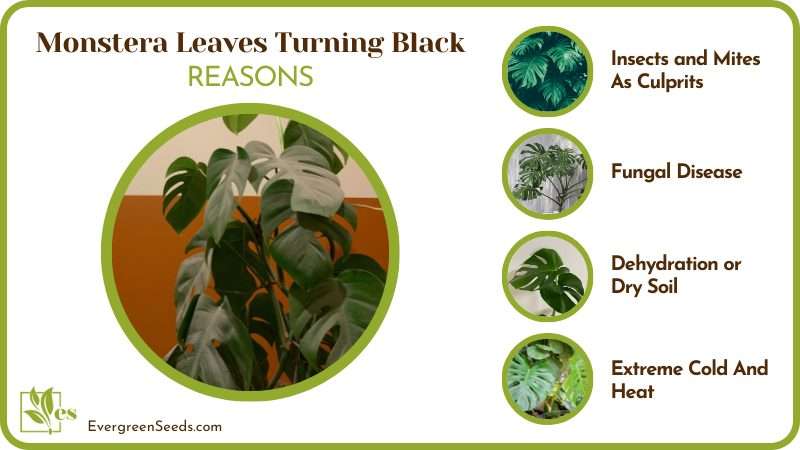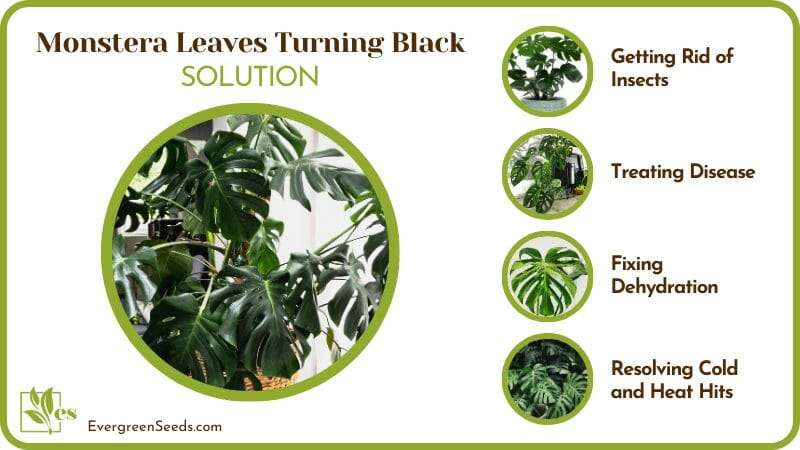Monstera leaves turning black is the most common ailment of these plants.

If you’re a proud owner of a Monstera plant, this will be your most common concern, as several different factors can cause it, which include insects, fungal diseases, cold and heat shocks, or overwatering. Check how to care Monstera Laniata and Lechleriana in our complete guide.
Today, we are going to walk you through the possible causes of your Monstera leaves turning black and how to fix the issue. So don’t despair – pour yourself a cup of joe and let’s dive right in!
JUMP TO TOPIC
Why Are Your Monstera Leaves Turning Black?
Your monstera leaves are turning black due to factors such as fungal diseases, dehydration, waterlogged soil, insects, etc. Specific fungal infections such as root rot or anthracnose can be very serious. Cold and heat shocks might also result in blacking leaves.
Monstera deliciosa, also called the Swiss cheese plant, is a delicate but sturdy and highly resistant plant from the philodendron family native to southern Mexico and Panama. Its characteristic holes in leaves are a beauty to behold.

This is an easy-to-care-for plant with largely no pests bugging it. However, things can go sideways if a monstera develops signs of root rot or if the leaves suddenly go black on you.
If you spot your leaves turning black, don’t despair just yet – your monstera is miles away from dying, and some simple remedies will bring it back to health in no time!
Of course, black leaves may be a sign of a much more serious disease, so you should act as fast as you spot the blackening of foliage. Early detection and proper reaction can be a lifesaver for your plant! In this article, we’re going to go through every possible cause of monstera leaves turning brown and even black.
– Insects and Mites As Culprits
The most common insects attacking your Monstera deliciosa plants will be sap suckers. These small pesky things often excrete and leave a sticky substance in their trails – this substance will cause mold and decay. As mold festers on leaves, they will soon turn black.
Mold is a fungus, and it can develop on any part of your monstera plant and can even spread to the soil, where mixed with water can cause the rotting of roots as well. But let’s talk about those insects and how they make your leaves go black.
Aphids are the most common pest attacking your monstera leaves and a big nuisance – they are the size of a sesame seed, which is why they are pretty hard to spot.
These pesky things vary in color, being translucent, white, black, and brown. They reproduce very quickly and leave a substance that will pretty soon make your leaves turn black. If these attack your monstera, biological control options are a viable solution!
Spider mites are another difficult-to-spot enemy of your Monstera deliciosa plant. These little critters weave silky threads and wrap themselves in them to catch water. This silky substance is the most obvious sign that you’re in trouble, as mites will soon decimate your leaves and leave them completely black!
Scale insects are small insects that can be brown, creamy, or black. Most of them are just an eighth of an inch small and are very hard to spot. Whenever you water your monstera, inspect your leaves closely, as scale insects will be really hard to get rid of once they begin to multiply!
– Fungal Disease
This list cannot go down without mentioning fungi-caused diseases. And for a good reason! Fungal spores are all around us, and just a single small change in the environment can cause an imbalance that will trigger disease in our plants!
Most diseases of this kind are caused when there’s an overwatered situation going on in the soil, but it can come from moisture in the air and high heat. The most common infections of plants include bacterial leaf spot and rust fungus.
Dark spots are caused by various species of bacteria either in the air or in water. Xanthomonas and pseudomonas bacteria are the most common and are especially concerning since they can survive and stay dormant for a prolonged time in both air and water.
A well-watered plant that enjoys appropriate light levels will be able to withstand infections. However, overwatered monstera plants exposed to extremes are more likely to get infected. Poor ventilation and humidity are big factors.
– Dehydration or Dry Soil
Overwatering is a surefire sign that your monstera leaves are turning black, but what about underwatered Monsteras?
Underwatering is as much dangerous and creeps slowly on us. It’s a much slower process, and monstera leaves take much longer to turn black. Without water, the plant doesn’t have enough to hydrate every part of itself.
As a result, your monstera will stop delivering water to those parts that can be renewed the easiest – leaves. Your leaves will begin to go black first on their extremities and edges before slowly going brown or black toward the center and the stem.
This will occur on the older leaves and those higher up the stem at first. Young leaves will still take the primary spot and receive more water from the stem, so when the plant finally receives the water, it will send it to young foliage.
If you keep your monstera in a spot with too intense a light, the topsoil and soil, in general, will take quicker to go dry. Poor soil won’t directly affect your leaves turning black, but the sun may burn your leaves, and dried soil will still add to the issues down the road. Soil that quickly goes dry will lose its conductivity and cause dehydration and poor nutrient and water absorption.
Whatever you do, don’t choose clay for your soil, or any soil that’s too compact, for that matter. This is the soil you shouldn’t over or underwater at any point, as when it goes dry, it will form a close grip on monstera roots, and the problems won’t go away until you do something to help your plant.
– Extreme Cold And Heat
Every plant has its preferences when it comes to ideal temperatures and the maximum and minimum it can handle. The temperatures at which you keep your plants in will largely impact the development and growth of said plants, and the same goes for your Monsteras!
Monstera is a tropical plant that loves warm and moist spells, with plenty of sun and light to enjoy. If you don’t allow these comforts to your monstera, it will rebel – and often, the results will be blackened leaves.
Low temperatures are often overlooked as even being a problem, but it’s exactly what can bring your monstera to ruin in the long run. Monsteras are large plants with mostly green parts (even the stem), and as such, it won’t tolerate prolonged cold spells.
Being big, they will need a lot of warmth and energy to warm their bodies, and the lowest a monstera can go is around 50 degrees Fahrenheit, and that’s a minimum you definitely shouldn’t go under!
Frost damages the sap and the flow inside the plant and causes your plants to stop growing. As a result, prolonged cold stress will even cause the sap to damage the tissue and make parts of your monstera turning black! This kind of physical damage is hard to bear.
Sunburns are more commonplace effects of temperature issues with many plants and are more evident and much quicker to show their symptoms. It’s a novice mistake to burn your plants when placing them in direct heat, but it’s the mistake we all correct the soonest in our hobbies as plant growers.
Sun leaves the foliage toasted, roasted, blackened, and brown, especially on the edges, and spreads fast to the entire parts of the foliage. What happens is that the plant loses water fast, and instead of the water going inside the cells, the sun pulls it out and cooks it on the leaves, and leaves serve as frying pans that quickly get toasted.
– Low Humidity And (Only) Misting
If your monstera is going weak on you even following the right water regime and adding good enough soil, you’re probably having humidity issues!
Your monstera, like any other natural living thing, is an opportunist and will attempt to drink water from anywhere it can, and this means air too. If your air is having too low humidity, your monstera may develop blackness on its leaves and even mold issues!
People are taking misting too eagerly these days, especially because it looks so effective and Instagram-worthy! So much so that misting will be their only way of watering monsteras, and this is wrong on so many levels.
Your monstera cannot survive only through drinking water through the foliage, and this isn’t natural. As a result, your monstera roots will suffer, and this will become evident by your foliage going black as well.
– Problems With Fertilization
If you’re an inexperienced grower, fertilization may be a puzzle to you. If you’re overdoing or undergoing your fertilization, the monstera will surely suffer.
Nitrogen deficit is a surefire way into stunted and degenerative growth and can even cause black spots and patches on your monstera leaves. If you’re not doing your fertilization properly, your monstera will go hungry and vulnerable to a large number of pest infestations and diseases.
– Root And Stem Rot
Overwatering and fungus that are created in root systems as a result will cause your roots and ultimately, stems to rot and die. Water clogging your plant, or its roots will deprive it of oxygen and cause monstera to develop root rot sickness, which you won’t escape so easily.
One of the later signs of root rot will become evident in your foliage developing black spots as well. The roots won’t be sending as many nutrients up the stem, and your stem won’t be able to push as many water particles to foliage, and it will go black as a result.
– Anthracnose Disease
Anthracnose is a fungal disease that you should be really afraid of when it comes to your monstera plants. It is caused by the fungus called Colletotrichum and leaves dark and dead leaf tissue near the main vein and center.
If you’re dealing with a prolonged case of anthracnosis, the leaves will go completely dry and develop brown spots. Those will often turn to black spots, and leaves will fall off on their own.
– Waterlogging And Lack of Light
Even if your monstera hasn’t developed any diseases, overwatering and water clogging can still be an issue, even if you have the perfect loose and aerated soil!
Make sure that you water your monstera in a tub or anywhere else, but on the tray it sits in! Your soil will release the water to the tray, but if you don’t get rid of this excess water, your monstera is in danger of becoming suffocated in it.
Other than water, your monstera will need plenty of light to thrive. Plenty of shade will cause the monstera to wilt and shed leaves, receiving black spots in the process.
How Can You Prevent Your Monstera Leaves From Turning Black?
You can prevent your monstera leaves from turning black by getting rid of insects and addressing the fungal infections with proper treatment.

You should also avoid overwatering the plant and leave the soil to dry between watering sessions. Adding adequate fertilizer can also help.
– Getting Rid of Insects
As soon as you spot a small batch of insects, it’s time to act! Handpicking them is your most effective solution. After you’ve done so, you can inspect the leaves and the plant thoroughly and make sure none are left. We mean thoroughly, as these won’t be very forgivable if you leave a single one.
If you’re not into touching these with your hands, you can wipe them away with a water jet or rinse them off with a mixture of water and rubbing alcohol. After the cleaning process, you can generously mist your plant with a mixture of water and neem or horticultural oil!
– Treating Disease
These diseases have to be treated as soon as they’re spotted. It’s crucial to remove all of the infected foliage and even parts of stems, as these are goners. Inspect your roots after pruning to see if the disease has come from down below. Re-pot your monstera in fresh soil, and fertilize with a general fertilizer to encourage new growth.
After you’ve quarantined your monstera for a few weeks, and made sure no diseases are bugging it, sprinkle it with fungicide and return to its previous growing place.
– Fixing Dehydration and Poor Soil Issues
If your monstera is seriously dehydrated, you should consider giving it a serious splash of water! Place your monstera under a 10-second sprinkling shower, allow the water to completely seep through the soil, and repeat with another 10-second soak up. If dehydration was the issue, you’ll hear your soil make a sound as water seeps through nooks and crannies of soil particles.
Another way of hydrating your monstera is taking the entire pot and drowning it in water for around a minute. After this, take the pot out of the water and let the water pass through, then repeat the process!
If you notice that your soil has quickly gone dry again, you may have caused hydrophobia in soil, which means that your soil doesn’t like water anymore. If that’s the rare case with your plant, you should re-pot your monstera in fresh soil.
If the dryness of the soil is caused by too compact particles or your soil is made of clay, you should consider giving some volcanic grit or other inorganic particles to the soil or completely changing the soil altogether.
– Resolving Cold and Heat Hits
When you notice that your plant is too cold, you should bring it to a warmer place. One common problem growers make is that they keep their growing rooms warm only during the day, and at night they let the temperature go down, which is when your monsteras are most prone to receiving cold hits.
If you’re moving your monstera to a warmer area, just make sure that you don’t shock them with too large a temperature difference all at once.
If you’re dealing with heat stress, on the other hand, you may want to keep your monsteras a bit further from the windows in the high afternoons.
Window glass may even focus direct sunlight on your leaves and create an ever greater burning effect. If you’re growing your monsteras in the summer, take them out, as they will enjoy summer breezes in warm weather and won’t get burnt as easily!
– Fixing Low Humidity and Misting
If your soil goes quickly dry after watering, it is an obvious sign that the air is too dry, and you need to raise the humidity in your plants’ living room.
If you don’t have much to spend, a small air humidifier is always a good solution. Or you can place wet stones at the bottom of your pot – this way, the water will slowly evaporate to the soil and the leaves, making the immediate vicinity humid enough.
Misting is a good watering option, but the technique shouldn’t be your main watering method. Instead, incorporate misting as a boost to your watering regime and practice it every three to five days to raise humidity and freshen your monstera up!
– Solving Fertilization Problems
If your monstera is still young, you can use granular fertilizer in this stage, and you can freely use the one with a lot of nitrogen, as the monstera will need plenty of it for growth! Always guide yourself with the general advice that you can find on a fertilizer label. If you need to encourage growth or add boost fertilizer, you can use liquid fertilizer diluted in water.
As far as fertilization schedules are concerned, apply general high nitrogen fertilizer in spring and summer, slowly taking away the fertilizer as you move into fall, and then slowly going low with nitrogen. Winter doesn’t require any fertilization as your monsteras will largely be dormant in this period.
– Solving Root Rot
Too much watering is a habit that you need to drop as soon as possible. Remember, less is always better when it comes to it. Your regular watering schedule shouldn’t be based on days – rather you should water Monsteras when the soil gets dry!
If you do have an issue with root rot, this calls for taking the plant out of the pot, cutting all the infected parts of roots and foliage, and replacing your soil. After this operation, you should quarantine your monstera to make sure that you’ve gotten rid of all the fungi in the soil and the roots.
– Preventing Anthracnose
To be sure you’re dealing with anthracnose, you need to have your monstera growing in near-ideal conditions. Fungal infections will often develop in the most perfect of conditions and generally come with moisture, which monstera needs to survive.
That’s why anthracnose won’t be so easily prevented, and your best bet is to cut off entire infected leaves and wait for the plant to push new foliage!
– Solving Waterlogging and Light Issues
Your monstera is a plant that needs ample ventilation, aeration, and drainage. These three factors are most important for a healthy plant. Imagine it as healthy roots leading to healthy plants. What you do with the soil is crucial, so ensure that you have good enough drainage to avoid issues with waterlogging.
Also, do your best to figure out perfect light conditions for your monstera and place it in a spot that receives a lot of sunlight with the least amount of shade, preferably only in the afternoon hours!












